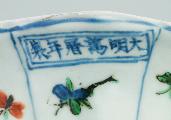
90.
ALTAR VASE
PORCELAIN DECORATED IN UNDERGLAZE BLUE AND
OVERGLAZE POLYCHROME ENAMELS IN THE
WUCAI
OR
‘FIVE COLOUR’ PALETTE
JINGDEZHEN KILNS, JIANGXI PROVINCE
MING DYNASTY, WANLI MARK AND PERIOD (1573–1619)
HEIGHT 61.5 CM; MOUTH DIAMETER 16.5 CM;
FOOT DIAMETER 15 CM
INV. NO. 737
Large
gu
-shaped altar vase, with globular
middle section, long trumpet neck with
everted, scalloped, lipped rim, on an everted
foot. Modelled with eight vertical lobes,
creating a fluted effect, emphasized by blue
lines in the intervening grooves, and
interrupted by raised horizontal bands on
the foot, shoulder and neck. Heavily potted
white porcelain covered in bluish glaze that
ends just above the unglazed base and is
marked by a thick orange line.
Decorated in deep cobalt blue and overglaze
polychrome enamels, including iron red,
yellow, green, brown and black. Each of the
eight panels on the globular middle section
contains two mythical animals, including
qilin
, flying horses, dragons and lions in
different poses, in a landscape with rockwork
and pine trees, the tops of which touch the
clouds. The neck is divided into three
horizontal sections above a key fret border
in alternating shades of blue, green and iron
red. Each panel in the lower section contains
a spray of
lingzhi
fungus surmounted by an
auspicious symbol, either a flaming pearl, a
pair of lozenges or an ingot; the raised band
is filled with two five-clawed dragons
chasing a flaming pearl. Each panel in the
upper section has flowers growing from an
elongated perforated rock, with two
butterflies hovering above. The main band
around the foot repeats the decoration in
the middle section and incorporates all the
above-mentioned animals as well as a tiger,
a white hare, an elephant (?) and an animal
resembling a dog. Above these panels a
white band and a band with small bouquets;
below the panels two bands, one containing
symbols such as a
ruyi
head, cash, an ingot,
a pair of books, crossed scroll paintings and
two dots, and the other containing flower
sprays. On the outside, below the rim a mark:
da Ming Wanli nian zhi
(made in the Wanli
period of the great Ming dynasty), written in
one line inside a rectangular cartouche, all in
underglaze blue.
Like the blue-and-white vase in this
collection (cat. 37), the shape of this altar
vase indicates that it was inspired by an
ancient bronze wine vessel, called
gu
, from
the Shang dynasty (ca. 1600-1027 BC). 1
Archaic
gu
and
zun
bronze wine vessels were
often reproduced in ceramics during the
Ming and Qing dynasties.
The
wucai
palette (literally ‘five colours’) and
the
doucai
palette (‘contrasting colours’) –
a combination of low-fired polychrome
enamels and underglaze cobalt blue – are
two of the most outstanding innovations of
the Ming era. Objects decorated with these
colour schemes were manufactured in two
stages: the underglaze blue was applied and
the object was fired, after which the enamel
decoration was added and the object was
fired a second time.
The
wucai
technique developed from the
Jiajing period (1522-1566) onwards and
assumed great importance during the Wanli
and Transitional periods (1620-1683), as
shown by objects produced at this time with
lively decoration in exuberant colours.
Vases of this quality, size and complexity
were probably made during the first half of
the Wanli period, before the Jingdezhen
factory closed in 1609.
Large
wucai
pieces are very rare. There is a
similarly shaped hexagonal vase with the
same mark in the Museum of Fine Arts,
Boston, 2 and a similar but much larger pair
in the Honno-ji temple in Kyoto. 3 According
to an inscription on the old box that held
one of the vases, this pair of vases was
donated to the temple by Chaya Nakajima
Chÿemon in 1645.
1 Chase, 1991, p. 47, no. 9.
2 Lion-Goldschmidt, 1978 b), pp. 184–85, no. 191.
3 Idem, ibid., p. 186; Hayashiya and Truber, 1977,
pp. 100–1, no. 56.
226 .
PORCELAIN OF THE YUAN (1279-1368) AND MING (1368-1644) DYNASTIES